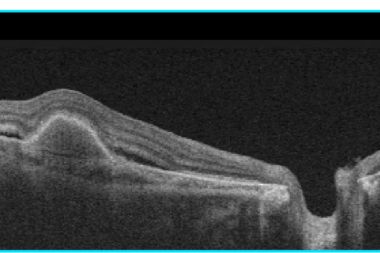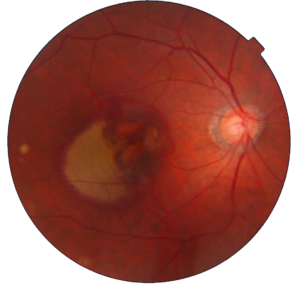
What is AMD?
The macula is the central portion of the back of the eye (retina) and responsible for central vision. Age-related macular degeneration (AMD) is a disease associated with aging that gradually destroys the sharp central vision and occurs most often after the age of 60. AMD usually occurs in both eyes, but the degree of involvement can vary between the two eyes.
AMD occurs in two forms

Dry AMD
Dry AMD is the more common type caused by a build-up of a fatty substance called drusen in macular. Itis more slowly progressive in causing visual loss usually over several years. But sometimes dry AMD can develop into wet AMD.

Wet AMD
Wet AMD is a type of late AMD that can develop suddenly and usually causes rapid vision loss. It happens when abnormal blood vessels leak fluid or blood into the macula. Early detection and treatment of wet AMD may help to reduce vision loss. In some instances, early treatment may recover vision.
What are the symptoms?
There may be no symptoms in the early stages of AMD. AMD isn’t painful. The first symptom is often a blurred or distorted area in your vision. If it gets worse, you might struggle to see anything in the middle of your vision. AMD can make things like reading, watching TV, driving or recognising faces difficult.
Wet AMD symptoms usually appear suddenly and may include:
- Reduced central vision in one or both eyes.
- Defined blurry spot or black spot in the field of vision.
- Visual distortions, such as straight lines seeming bent.
- The need for brighter light when reading or doing close-up work.
- Objects in front of you might change shape, size, or colour, or seem to move or disappear.
Macular degeneration doesn’t affect side vision, so it doesn’t cause total blindness.
How is wet AMD diagnosed?
Your optometrist can test your vision, use color photography or Optical Coherence Tomography (OCT) scans to detect early signs of wet AMD. OCT scans create cross-sectional images of the retina. If wet AMD is suspected, you should be referred to an Ophthalmologist (eye specialist) by your optometrist or GP for treatment urgently (within two weeks).
How is AMD treated?
Smoking, obesity, high blood pressure, Caucasian race, family history of AMD increase the risk of AMD. There is currently no treatment for dry AMD unless it develops into wet AMD.
Eye (intravitreal) injections are required to treat wet AMD. These drugs include Lucentis (ranibizumab), Eylea (aflibercept), Beovu (brolucizumab), and Vabysmo (faricimab) and are currently available in Australia. The aim of treatment is firstly to prevent further loss of vision. Improvement in vision occurs in many patients, but certainly not all. In some patients, vision can worsen despite treatment.
Here’s what you can generally expect with anti-VEGF injections for wet AMD:
Frequency of Injections: Initially, you may receive monthly injections to quickly address the abnormal blood vessel growth in the macula. The frequency may decrease over time based on how well your eye responds to the treatment.
Procedure: The injections are usually performed in an outpatient setting, often in the ophthalmologist’s clinic. The eye is typically numbed with local anaesthesia eye drops before the injection. The injection itself is administered with a thin needle directly into the vitreous, the gel-like substance inside your eye.
Duration: The entire procedure is relatively quick and may take about 15-30 minutes, including preparation time. Your entire appointment may take 1.5 hours including vision assessment and scans to track how well your eye is responding to the treatment.
Potential Discomfort: While the injection itself is generally not painful due to the numbing medication, you may feel some pressure or discomfort during and after the procedure. It is crucial to communicate any discomfort to your healthcare provider. You may be sent home with some lubricating eye gel to relieve some discomfort.
Potential Side Effects: Though rare, there can be complications or side effects, such as infection, increased intraocular pressure, or retinal detachment. Your ophthalmologist will discuss these risks with you before starting the treatment.
Vision Improvement: Many patients experience improvements in vision or stabilization of vision loss after anti-VEGF treatment. However, individual responses can vary, and not everyone will respond in the same way. In some cases, vision may not improve with treatment.
Long-Term Treatment: Wet AMD is a chronic condition, and ongoing treatment may be necessary to maintain the benefits of the injections. Your ophthalmologist will determine the appropriate treatment plan based on your individual response to therapy.
It is crucial to maintain regular follow-up appointments with your eye specialists to monitor your progress and make adjustments to your treatment plan as needed.
Additionally, communicate any changes in your vision or any concerns about the treatment with your healthcare team.

